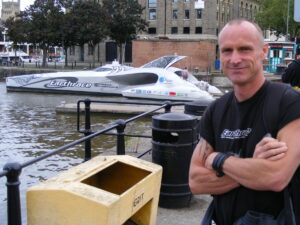Explore about the Famous Explorer Pete Bethune, who was born in Canada on April 4, 1965. Analyze Pete Bethune’s net worth, age, bio, birthday, dating, height-weight, wiki. Investigate who is Pete Bethune dating now? Look into this article to know how old is Pete Bethune?
Pete Bethune Birthday Countdown
Pete Bethune Biography
Captain Peter James Bethune (born 4 April 1965) is a New Zealand ship’s captain with 500 ton master licence, published author, producer of The Operatives TV Show, and public speaker. He is the founder of Earthrace Conservation . He works assisting countries in Asia, Central America and Africa with fisheries enforcement and anti-poaching. He is the holder of the world record for circumnavigating the globe in his powerboat Earthrace, a wavepiercing trimaran powered with biofuels. Earthrace was renamed the Ady Gil in 2009 and Captain Bethune sailed it in Antarctica for Sea Shepherd Conservation Society to disrupt Japanese whaling activities. The vessel was involved in a collision with a Japanese whaling vessel. He subsequently boarded the whaling vessel the Shonan Maru 2 and presented the Captain with an invoice for the Ady Gil and attempted to arrest him. Captain Bethune was detained and taken back to Japan and charged with a number of offences related to his trespassing and assault and received a suspended sentence.
He began his career as an oil exploration engineer for Schlumberger Wireline Services and worked in the North Sea and Libya. In 1997, he co-founded CamSensor Technologies. The company manufactures automated camera systems for controlling robots used in complex tasks such as cutting up and grading meat carcasses. He later moved to Sydney to establish a subsidiary there.
His entry into conservation started when he wrote a 20,000-word paper titled “Alternative Fuels for Road Transport” while pursuing his Master of Business Administration degree from Macquarie University in 2004 He concluded that hydrogen as a fuel was a dead-end, but that biofuels such as biodiesel and ethanol could become mainstream in use. He also predicted the battery electric vehicle could eventually replace the combustion engine in terms of road transport. For leisure, Captain Bethune enjoys camping, scuba, freediving, kayaking, and CrossFit. He told a reporter for The New Zealand Herald: “I’ve come from a very unusual background to be a conservationist.”
When Earthrace was first launched in 2006, Captain Bethune took her on a promotional tour around New Zealand. The vessel was given a Maori blessing in Raglan before she left to cross the Pacific. Over the next three years, the team took the boat to 186 cities around the world, opening the boat to school groups, public, media, and sponsors. Through this time, over 250,000 people walked aboard the vessel. Captain Bethune used the tour to promote awareness of alternative fuels such as biodiesel.
His first attempt began in Barbados on 10 March 2007. He encountered significant delays due to issues with the propellers and other mechanical problems. On the night of 19 March, while around 22 kilometres (14 mi) offshore from Guatemala, Earthrace collided with a local fishing boat. The crew was absolved of any responsibility after a 10-day investigation during which they were held in custody under armed guard in the military compound in Puerto Quetzal. The delays prevented them from completing the circumnavigation in record time using their original start location. The crew took Earthrace to San Diego where they made repairs. They then restarted their record attempt, leaving San Diego on 7 April 2007. Once they rounded Aceh in Indonesia and started crossing the Indian Ocean the vessel encountered significant bad weather in the first monsoon of the season. The monsoon remained with them all the way to Salalah in Oman. The vessel passed through the Suez Canal, then when getting close to Spain, crew discovered a structural failure around the depth transducer. Bethune said the “failure was a result of the constant pounding in crossing the Indian Ocean”. Crew made temporary repairs and headed out to cross the Atlantic, however the repairs failed and Earthrace limped back to port in Málaga, Spain. Bethune decided to abandon the attempt. Captain Bethune returned to New Zealand to recover from what he said was “a brutal ordeal”. After meeting with some of his original sponsors, he assembled a new team. The vessel was repaired and departed from Sagunto, Spain, in another record attempt on 1 March 2008. The second record attempt also suffered a large number of setbacks. The auto-pilot system failed in the Atlantic crossing. This was repaired in Puerto Rico. There was a general strike in Panama Canal causing 3 days in delays waiting to transit the canal. In the leg between Hawaii and Marshall Islands, there was a problem with the common rail injection system, which was repaired in Majuro. The crew then had their biggest setback in Palau, when Earthrace hit a submerged log a few nautical miles offshore. The vessel limped back into Palau with extensive damage. A list of problems included a bent driveshaft, propeller damage, smashed P-Bracket, smashed engine mounts, broken gearbox, rudder damage, and a 5-metre gouge down the starboard side of the composite hull. Crew determined it would be almost impossible to repair the vessel quickly in Palau. They made temporary repairs and ran on one engine to Singapore. On arrival, the initial assessment was repairs would take at least 2 weeks, which would make the record almost impossible to get. Marine salvage company Posh Semco offered to help with haul-out, and the vessel was pulled from the water. Crew worked around the clock for 3 days. Earthrace was put back into the water with what Captain Bethune described as “the ugliest composite repair” he’d ever seen. Crew continued on their voyage towards their finish line in Spain. Captain Bethune finished at the Spanish port of Sagunto on 27 June. The journey was completed in 60 days, 23 hours and 49 minutes, beating the former record by over two weeks. Captain Bethune later confessed the reason they missed the record on the first attempt was his leadership was poor. He said the real difference in the second successful attempt was he did a better job in making decisions and running the team. He also claimed his team had been outstanding in Singapore. They had achieved a small miracle in getting Earthrace repaired so quickly, in very challenging circumstances.
After touring ports around the globe, the Earthrace was put on sale for $3 million and Captain Bethune considered using it to interfere with Japanese whaling in the Southern Ocean if a buyer could not be found. Hollywood production-house owner Ady Gil purchased the boat and Earthrace was renamed after him on 17 October 2009. Gil leased the ship to Sea Shepherd Conservation Society for $1 / year to pursue Japanese whalers in Antarctica. Captain Bethune was put in charge of the refit and was to captain the vessel in its anti-whaling activities. Captain Bethune said before the operation: “I’m a conservationist. One of the things I’ve learned on Earthrace is stand up for stuff you believe in. Year after year the Japanese go down there and nothing seems to change … If they want to go amping things up a bit, then bring it on.” His wife later told the press that he first became alarmed by the state of the oceans when skippering the vessel during the record attempts.
Captain Bethune grew up in Hamilton West, New Zealand as one of five children. He completed a Master of Business Administration at the Macquarie Graduate School of Management, Bachelor of Science at the University of Waikato, and a Bachelor of Engineering at the University of Auckland. He has two daughters with his wife, Sharyn, his high school sweetheart, from whom he divorced in 2009.
Based largely on testimony from Captain Bethune and former Sea Shepherd Bob Barker Captain, Chuck Swift, Ady Gil successfully sued Sea Shepherd for the deliberate abandonment of his vessel in Antarctica. In siding with Mr. Gil, the arbitrator awarded him compensatory damages of $500,000 plus interest from 8 January 2010 forward.
Captain Bethune disassociated himself from Sea Shepherd by posting an open letter on his Facebook page on 4 October 2010, condemning the organisation and its leader Paul Watson as “dishonest” and “morally bankrupt”. According to his letter, he was directed by Paul Watson to sink the Ady Gil deliberately for PR purposes after the collision with the Japanese whaling ship. He insists that the senior members of Sea Shepherd regularly lie and conspire over serious matters, detailing many cases in his letter.
On 15 February 2010 in the middle of the night, Captain Bethune attempted to board the Shōnan Maru 2 from a jet ski. On his first attempt he fell into the water, and was recovered by his Engineer, Larry Routledge a few minutes later. On his second attempt, Captain Bethune managed to climb between the anti-boarding spikes and onto the side of the hull, where he then cut through the protective netting and clambered aboard. The purpose of the boarding was to conduct a citizen’s arrest on her captain, Hiroyuki Komiya, alleging attempted murder, and to present a claim for $3 million for the ramming of his vessel. Captain Bethune was not successful in arresting Komiya, nor did he receive any compensation. Captain Bethune was successful however in getting taken to Japan to face charges, which he hoped would increase public awareness of Japanese whaling. Japan’s Institute of Cetacean Research issued a statement calling it a publicity stunt. He was detained by the ship’s crew and taken to Tokyo, where he was arrested by the Japanese Coast Guard on 12 March on charges of trespassing. On 2 April 2010, Captain Bethune was indicted in Japan on five charges: boarding a vessel without due cause, illegal possession of a knife, destruction of property, assault and obstruction of business. The assault charge was based on the allegation that he threw a bottle of butyric acid onto the Shōnan Maru 2 days before the boarding, causing chemical burns to a whaler’s face. The Sea Shepherd group claimed the burns were self-inflicted when the crewman was shooting pepper spray at the protesters. Captain Bethune could have faced up to 15 years in prison if found guilty of injury, or up to three years if found guilty of trespass. His lawyer claimed the charges were unfounded and stated that his client would strongly deny them. He was held without bond in the maximum security Tokyo Detention Center while he stood trial. Bethune’s trial began on 27 May. Captain Bethune was charged with intruding on the ship, forcibly obstructing business, violating the Firearms and Swords Control Law and damaging property.
On 6 January 2010 the Ady Gil was involved in a collision with the Japanese whaling vessel MV Shōnan Maru 2 in the Southern Ocean when the Shonan Maru No 2 hit it, and the Ady Gil was subsequently abandoned. An investigation into the collision by the Australian Maritime Safety Authority (AMSA) was inconclusive in assigning blame for the collision. AMSA was unable to verify claims made by Sea Shepherd, while the Japanese government declined to participate with the investigation saying any information it had might be needed for an inquiry by its own authorities. However Maritime New Zealand investigators released a report that the Ady Gil was the stand on vessel and had right of way. The Shonan Maru No 2 was the port side vessel, and the overtaking vessel, and under both circumstances, had an obligation to keep well clear of the Ady Gil. The report did conclude however that the captains of both the Ady Gil and the whaler, the Shonan Maru No 2, “were partly responsible for either contributing to, or failing to respond to the ‘close quarters’ situation that led to the collision”.
In 2011 Captain Bethune formed a team of military veterans and specialist civilians to catch and prosecute environmental criminals. This led to the development of The Operatives TV Series, which so far has run for two seasons and aired in over 90 countries. Units represented in the team included former US Navy SEAL Team 6 and 2, US Marine Recon, US Army Ranger, French 1er regiment (SAS) and New Zealand Paratrooper. Each episode involves Captain Bethune and his team examining some form of environmental criminal activity working alongside existing law enforcement units. 18 episodes have been filmed dealing with issues such as shark finning, illegal logging, marine protected area, IUU FIshing, wildlife smuggling, blast fishing, cyanide fishing, seal hunting and wildlife poaching
Captain Bethune founded his own conservation organisation in 2011, Earthrace Conservation. and he assists government agencies with illegal fishing, wildlife poaching and other environmental crimes. It has non-profit or charity status in New Zealand, US and UK. He also has a Television Show “The Operatives” that follows his team’s work. Captain Bethune employs former military personnel that undertake the missions. In 2013, Captain Bethune was running fisheries patrols in the Guanacaste region of Costa Rica. His team had been flying a Skylark military drone at night over the surrounding waters when they detected a vessel the Amelita, allegedly fishing inside a Marine protected areas. Bethune launched his patrol boat from shore and approached the Amelita. The team covertly filmed the Amelita engaged in shrimp trawling, following her for 7 hours. On daybreak, crew of the Amelita pulled in their trawl nets. Bethune boarded the vessel, filmed the catch, and interviewed the Captain, who claimed to be the President of the Commercial Fisherman’s Association in Puntarenas. Bethune handed the evidence over to a local NGO and Costa Rican authorities who prosecuted the Captain. Bethune travelled back to Costs Rica in 2015 to provide additional evidence in the court case.
In July 2012, Captain Bethune and Jack Waldron, a former New Zealand Paratrooper, entered a De Beers Diamond Mine near Luderitz in Namibia. They were dropped a mile offshore at night by a zodiac, and swam ashore into the mine area. Over the next four days, Captain Bethune and Waldon avoided security patrols while trying to film the government sanctioned seal clubbing. On the final day, Captain Bethune is hiding in a gillie suit about 50 meters from where a group of seal clubbers have assembled. He films the clubbing of around 500 baby seals. The two men by now are out of food and water, and bad weather prevents them from being picked up by zodiac. They end up hiking out of the diamond mine at night. The video has since been used by various animal rights and conservation groups including PETA. It was also used in the first episode of The Operatives TV Show. In 2015, Captain Bethune presented a 200,000 strong petition to Jake Jacobs, Secretary of the Namibian National Assembly, asking the government to abandon the seal clubbing industry.
In 2012, Captain Bethune started Earthrace Conservation that works on conservation and environmental campaigns. His team consists of former military personnel, and they are involved in fisheries enforcement, anti-poaching, and stopping wildlife smuggling. Many of the missions have been filmed and made into the TV Series The Operatives that has now aired in around 90 countries. More recently his work has involved training government teams on coastal and offshore surveillance, fisheries enforcement, and maritime security.
In 2013, Captain Bethune assembled his team in Costa Rica and they ran several missions targeting illegal gold mining in the Corcovado National Park, training and working alongside the government MINAE forces. Rangers claimed the gold miners were destructive by killing and eating endangered wildlife, causing extensive erosion along creek and river beds, and using cyanide poison to separate gold from the silt. Jack Waldron gathers aerial intelligence by flying a paramotor over the jungle, locating multiple areas of interest. The full team is inserted into the jungle by rappelling from a Bell UH1H helicopter. The campaign led to a number of successful prosecutions and 2 illegal gold mining operations were closed down. There were 2 cases of gunshots being fired at the Rangers by fleeing gold miners.
In 2017, Captain Bethune was in the Philippines training local fisheries enforcement teams consisting of personnel from Navy special forces, Ministry of Fisheries (BFAR) and local police (Bantay Dagat). While on patrols at night on 26 May, they came across a Danish Seine trawler the “Dan Israel R”, allegedly fishing inside municipal waters. Danish Seine is a form of destructive bottom trawling banned in the Philippines. Crew of the Dan Israel R were arrested and the vessel escorted into the BFAR impound facility in Cavite. The vessel was one of 23 in a so-called Alphabet fleet. Owners of the vessel subsequently made a cash offer of 2 million pesos to settle the case.
What's Pete Bethune Net Worth 2024
| Net Worth (2024) | $1 Million (Approx.) |
| Net Worth (2023) | Under Review |
| Net Worth (2022) | Under Review |
| Net Worth (2021) | Under Review |
| Net Worth (2020) | Under Review |
Pete Bethune Family
| Father's Name | Not Available |
| Mother's Name | Not Available |
| Siblings | Not Available |
| Spouse | Not Available |
| Childrens | Not Available |





